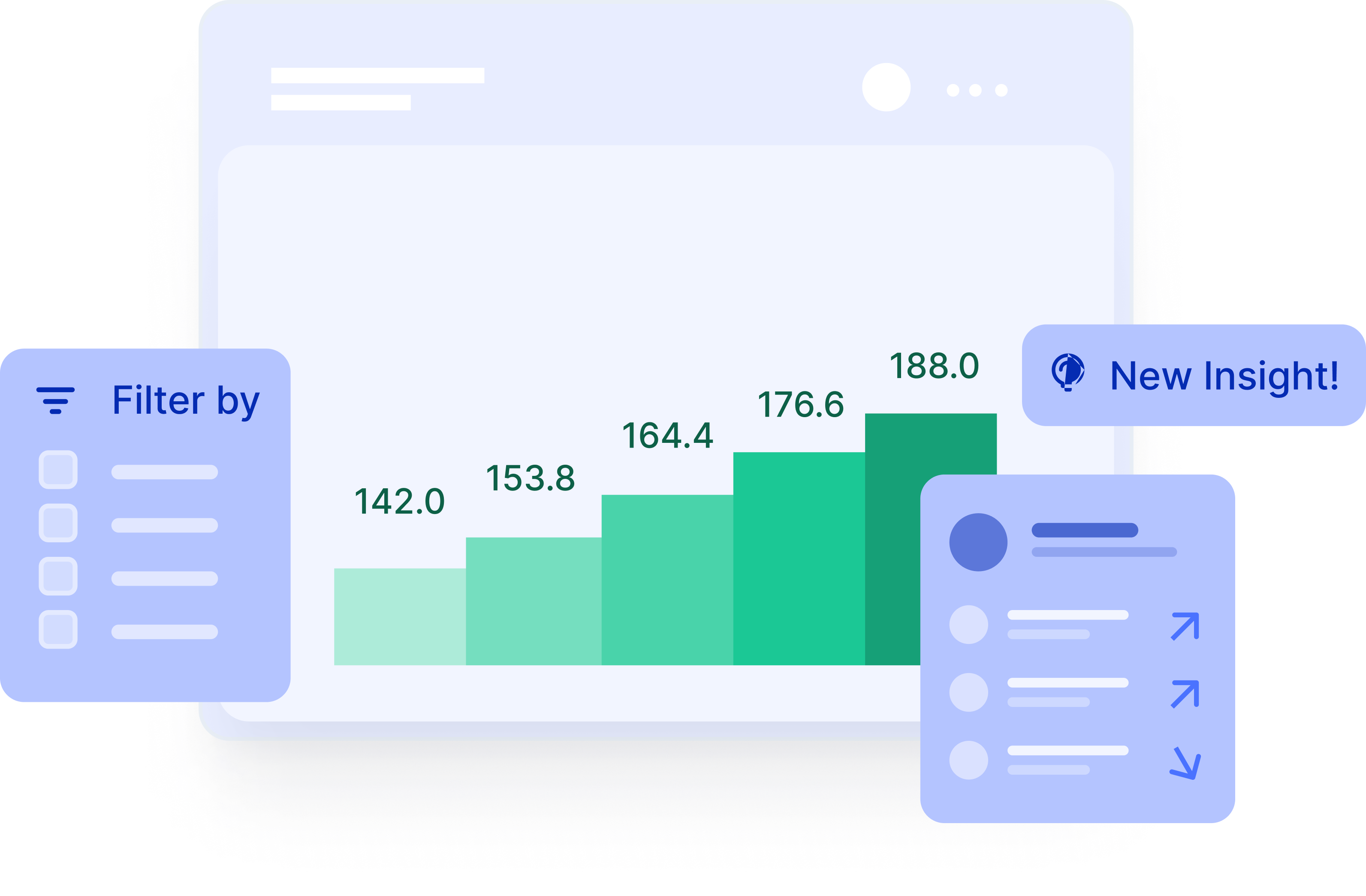Pipeline Conversion Rate: Formula, Calculation, and Optimization
What is pipeline conversion rate?

Conversion rates in general help us understand what proportion of a starting amount has been successfully converted and concluded. The pipeline conversion rate metric indicates the share of pipeline opportunities which were won (converted to Bookings) in each period.
Understanding PCR is essential for sales teams aiming to improve performance. A high pipeline conversion rate indicates a strong sales process, while a low rate highlights areas needing improvement, such as lead qualification, follow-up strategies, or sales process efficiency.
Why is pipeline conversion rate important to measure?

Direct Impact on Business Growth
PCR plays a key role in revenue generation. Businesses with an optimized conversion pipeline experience faster revenue growth without increasing customer acquisition costs.
Sales Forecasting and Strategy Adjustments
Accurate sales forecasting depends heavily on conversion rate analysis. By measuring conversion ratios regularly, companies can anticipate revenue, adjust sales targets, and allocate resources more effectively.
Improved Sales Team Efficiency
Monitoring PCR reveals process gaps. It helps sales managers refine the pipeline coverage formula, measure conversion rate improvements, and evaluate team performance.
Real-World Example
A SaaS company with $1 million in starting pipeline expects $250,000 in bookings if its PCR is 25%. Increasing this metric by just 10% could boost revenue to $350,000 without adding new leads.
How is pipeline conversion rate calculated?

The basic formula for calculating the pipeline conversion rate involves dividing the amount of pipeline opportunities which were won by the amount of all pipeline opportunities.
PCR = (Number of Closed Deals / Total Deals in the Pipeline) × 100
Step-by-step Guide:
- Identify Total Pipeline Deals: Count all deals in the pipeline at the start of a specific period.
- Calculate Closed Deals: Determine the number of deals closed within that timeframe.
- Apply the Formula: Use the conversion rate equation to calculate PCR.
Example Calculation:
If a sales team starts the quarter with 200 deals and closes 50:
PCR = (50 / 200) × 100 = 25%
This metric comes in three variations which offer different benefits depending on the situation:
Net conversion rate
The share of the starting pipeline which was successfully converted to Bookings during the period. This metric is useful in answering the question "how much of the starting pipeline do we expect to be closed-won as Bookings?". This metric should also be calculated for each pipeline forecast category.
Gross conversion rate
The ratio between the starting pipeline and Bookings during the period. This metric accounts for changes and new opportunities added during the period and is useful in answering the question "what is the amount of Bookings we won - in total - compared with our starting pipeline?". It enables measuring historical success rates, comparing results between periods, and creating projections based on the starting pipeline of current or future periods.

Access pipeline waterfall template
Track and analyze your pipeline throughout the quarter

Total conversion rate
This metric indicates the share of the total open pipeline that was closed-won in a given period. The total potential open pipeline includes new Pipeline, pulled-In opportunities and changes to starting pipeline. It provides a measure of how successful the company has been in converting the potential pipeline within a given period to closed-won bookings.

Advanced Strategies for Optimizing Pipeline Conversion Rate
- Lead Qualification:
Evaluate leads based on engagement and buying intent using a robust sales pipeline calculator. - Sales Process Streamlining:
- Use automation tools for pipeline management.
- Eliminate unnecessary stages and focus on actions that drive deal closure.
- Sales Funnel Analysis:
Conduct a conversion analysis of each sales stage. Identify bottlenecks and optimize actions to push deals toward closure. - Sales Training:
Regularly train sales reps on best practices, such as how to calculate conversion rates accurately and refine customer engagement tactics.
Tools and Techniques for Tracking Pipeline Conversion Rate
To track and optimize PCR, consider these tools:
- CRM Platforms: Tools like Salesforce and HubSpot automate pipeline tracking and calculate conversion ratios.
- Sales Analytics Software: These platforms provide in-depth conversion rate analysis with customizable dashboards.
- Pipeline Management Tools: Use tools that offer features like sales conversion rate calculators to simplify metric tracking.
Automation Benefits:
Automating conversion rate monitoring reduces manual errors, streamlines reporting, and enables proactive adjustments to the sales strategy.
Common Pitfalls and How to Avoid Them
- Overlooking Lead Qualification:
Failing to filter leads results in a clogged pipeline and a lower PCR. Use data-driven lead scoring to assess prospects. - Ignoring Sales Process Bottlenecks:
Slow-moving pipelines reduce conversions. Conduct regular sales process audits to identify and fix bottlenecks. - Focusing Only on Win Rate vs Close Rate:
While win rate vs close rate comparisons are useful, PCR considers the full pipeline, offering a more comprehensive performance view. - Neglecting Follow-Up:
Delayed follow-up leads to lost deals. Automate reminders and create personalized follow-up sequences to stay ahead of competitors.
Conclusion
Understanding and optimizing the Pipeline Conversion Rate is critical for business growth. A well-managed conversion pipeline ensures a steady flow of closed deals, higher revenue, and improved sales performance. Businesses should track PCR consistently, conduct regular conversion analysis, and adjust sales tactics based on calculated metrics.
By focusing on factors like lead quality, sales process efficiency, and sales training, companies can improve their sales conversion rate and maintain a competitive edge in their industry. Implementing CRM tools, using sales pipeline calculators, and avoiding common pitfalls will ensure a more predictable and profitable sales process.
For more information on pipeline conversion

All the SaaS revenue metrics you need
Pipeline conversion rate is only one of the hundreds of SaaS metrics that are available out-of-the-box to users of the Sightfull revenue analysis and optimization platform. It includes all of the critical metrics required for SaaS companies, from indicators regarding campaigns and lead conversions, through those that track pipeline, conversion and bookings, and all the way to later signals such as retention and expansion.
These highly precise customizable metrics are automatically calculated based on a large repository of SaaS industry standards, best practices and benchmarks. This saves lots of time for RevOps teams since they don’t have to rely on data analysts for support, waste time on error-prone spreadsheets, or manually create and update dozens of reports.
Sightfull users also receive dozens of pre-built dashboards based on these metrics, enabling them to easily analyze revenue trends at a highly granular level, identify their root causes, and act on proactive insights regarding time-sensitive business issues.
Related metrics
Also known as:
- Sales conversion rate
- Opportunity conversion rate
- Conversion efficiency
- Sales win rate
- Sales closing rate
- Prospect-to-customer conversion rate



Sightfull is your automated GTM analytics platform.
Low touch, quick deployment paired with automation ensures fast results across any interface of your choice.


















